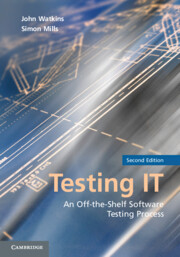Book contents
- Frontmatter
- Contents
- Foreword to the Second Edition by Geoff Thompson
- Foreword to the First Edition by Maurice Rosenburgh
- Acknowledgments
- 1 Introduction
- PART 1 THE TRADITIONAL TESTING PROCESS
- 2 An Overview of Testing
- 3 Testing Techniques
- 4 The Management and Planning of Testing
- 5 Unit Testing
- 6 Integration Testing
- 7 System Testing
- 8 Systems Integration Testing
- 9 User Acceptance Testing
- 10 Operations Acceptance Testing
- 11 Regression Testing
- 12 Improving the Testing Process
- 13 Introduction, Adoption, and Maintenance of the Testing Process
- 14 Agile Testing
- PART 2 THE TESTING PROCESS IN THE REAL WORLD: ILLUSTRATIVE CASE STUDIES
- PART 3 THE APPENDICES
- References
- Glossary
- Index
2 - An Overview of Testing
Published online by Cambridge University Press: 03 May 2011
- Frontmatter
- Contents
- Foreword to the Second Edition by Geoff Thompson
- Foreword to the First Edition by Maurice Rosenburgh
- Acknowledgments
- 1 Introduction
- PART 1 THE TRADITIONAL TESTING PROCESS
- 2 An Overview of Testing
- 3 Testing Techniques
- 4 The Management and Planning of Testing
- 5 Unit Testing
- 6 Integration Testing
- 7 System Testing
- 8 Systems Integration Testing
- 9 User Acceptance Testing
- 10 Operations Acceptance Testing
- 11 Regression Testing
- 12 Improving the Testing Process
- 13 Introduction, Adoption, and Maintenance of the Testing Process
- 14 Agile Testing
- PART 2 THE TESTING PROCESS IN THE REAL WORLD: ILLUSTRATIVE CASE STUDIES
- PART 3 THE APPENDICES
- References
- Glossary
- Index
Summary
“As we strive to implement the new features of our applications, there is one thing we can say with absolute certainty – that at the same time, we also introduce new defects.”
Introduction
This chapter provides an overview of testing to provide an understanding of what testing is and why it is such a challenge. It also emphasizes that whenever we test software, the process must be made as efficient and effective as possible.
Readers familiar with the need for efficient and effective testing may not need to read this chapter.
The Challenge of Testing
So, just how difficult is testing? To help answer this question, consider the following example.
Imagine we have a requirement to test a simple function, which adds two, thirty-two bit numbers together and returns the result. If we assume we can execute 1,000 test cases per second, how long will it take to thoroughly test this function?
If you guessed seconds, you are way out. If you guessed minutes, you are still cold. If you guessed hours, or days, or even weeks you are not even slightly warm. The actual figure is – 585 million years.
But surely this is a daft example. Nobody in his or her right mind would test such a function by trying out every single possible value! In practice, we would use some formal test design techniques such as boundary value analysis and equivalence partitioning to help us select specimen data for our test cases (see Chapter 3 for details of test design techniques).
- Type
- Chapter
- Information
- Testing ITAn Off-the-Shelf Software Testing Process, pp. 9 - 15Publisher: Cambridge University PressPrint publication year: 2010



